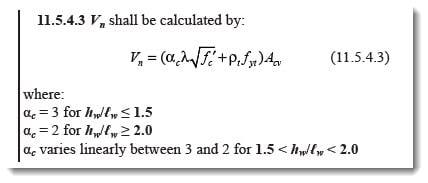Two very closely related questions:
In ACI 318-14, Eq. 11.5.4.8 defines Vs. It uses (d/s) as part of that calculation. From back in my school days, I remember that all of this used to be based on the concept that a shear crack would propagate at 45 degrees, meaning that a theoretical shear failure crack would have a vertical (and horizontal) dimension of d. So the number of horizontal bars that the diagonal crack would cross is (d/s). But in the case of a shear wall with h/L << 1 (a long wall compared to its height), a 45-degree crack would not run the full length of d. It might be appropriate to say that the crack would have horizontal and vertical dimensions more like h. So why doesn't ACI 318-14 make any adjustment for aspect ratio of shear walls?
In ACI 318-19, the resistance due to shear reinforcing is rho_t * fyt * Acv:

And ACI is clear that rho_t refers to horizontal steel in a shear wall:

And they remove any doubt that rho_t is the ratio of that horizontal steel area to the area of concrete perpendicular to the reinforcement:

So why are they having us multiply rho_t by Acv, when Acv is the area of the "shear plane", NOT the area of concrete perpendicular to the shear reinforcement?:

Director of Technical Services
ENERCALC, Inc.
Web:
In ACI 318-14, Eq. 11.5.4.8 defines Vs. It uses (d/s) as part of that calculation. From back in my school days, I remember that all of this used to be based on the concept that a shear crack would propagate at 45 degrees, meaning that a theoretical shear failure crack would have a vertical (and horizontal) dimension of d. So the number of horizontal bars that the diagonal crack would cross is (d/s). But in the case of a shear wall with h/L << 1 (a long wall compared to its height), a 45-degree crack would not run the full length of d. It might be appropriate to say that the crack would have horizontal and vertical dimensions more like h. So why doesn't ACI 318-14 make any adjustment for aspect ratio of shear walls?
In ACI 318-19, the resistance due to shear reinforcing is rho_t * fyt * Acv:

And ACI is clear that rho_t refers to horizontal steel in a shear wall:

And they remove any doubt that rho_t is the ratio of that horizontal steel area to the area of concrete perpendicular to the reinforcement:

So why are they having us multiply rho_t by Acv, when Acv is the area of the "shear plane", NOT the area of concrete perpendicular to the shear reinforcement?:

Director of Technical Services
ENERCALC, Inc.
Web:
